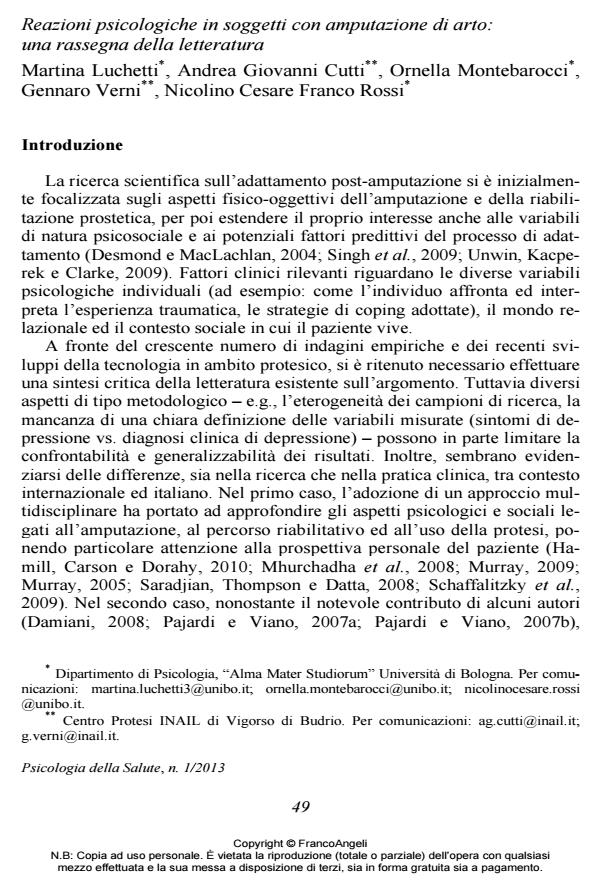Psychological reactions in subjects with limb amputation: a review
Journal title PSICOLOGIA DELLA SALUTE
Author/s Martina Luchetti, Andrea Giovanni Cutti, Ornella Montebarocci, Gennaro Verni, Nicolino Cesare Franco Rossi
Publishing Year 2013 Issue 2013/1
Language Italian Pages 22 P. 49-70 File size 329 KB
DOI 10.3280/PDS2013-001003
DOI is like a bar code for intellectual property: to have more infomation
click here
Below, you can see the article first page
If you want to buy this article in PDF format, you can do it, following the instructions to buy download credits

FrancoAngeli is member of Publishers International Linking Association, Inc (PILA), a not-for-profit association which run the CrossRef service enabling links to and from online scholarly content.
The aim of this paper is to clarify the current state of knowledge on psychological adjustment post-amputation, providing a critical analysis of methodological issues and illustrating some tools specifically ideated to investigate psychosocial problems faced by amputees. Research results show the presence of significant anxiety-depressive symptoms in the short period after the trauma, as well as at a distance of several years. However, some potentially critical phase, such as the period immediately after discharge from rehabilitation centers in which the support of therapy is reduced, remain insufficiently explored. Due to the complex nature of the adjustment process to limb loss, several authors have highlighted the need for further longitudinal studies to investigate the evolution of psychological reactions in different stages of rehabilitation and prosthetic fitting, in short- and long-term postamputation. Consider not only medical-prosthetic factors, but also psychosocial ones is relevant for both research and clinical practice.
Keywords: Limb amputation, adjustment, depression, anxiety, post-traumatic stress disorder.
- Avaliação da ansiedade e depressão em familiares de crianças em tratamento quimioterápico Ariana Aparecida Lins Aleksandrov Salum, Fernanda Paula Cerântola Siqueira, Josiane Ramos Garcia Rodrigues, Antonio Carlos Siqueira Júnior, in Revista Científica Multidisciplinar Núcleo do Conhecimento 121233/2022 pp.220
DOI: 10.32749/nucleodoconhecimento.com.br/saude/tratamento-quimioterapico
Martina Luchetti, Andrea Giovanni Cutti, Ornella Montebarocci, Gennaro Verni, Nicolino Cesare Franco Rossi, Reazioni psicologiche in soggetti con amputazione di arto: una rassegna della letteratura in "PSICOLOGIA DELLA SALUTE" 1/2013, pp 49-70, DOI: 10.3280/PDS2013-001003